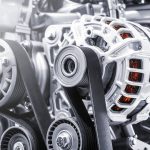A simple machine is a device with the help of which heavy loads are lifted by applying small effects in a convenient direction. Pulley used to lift water from a well and screw jacks used to lift motor car are some of the common examples of simple machines. In this chapter some of the terms connected with simple machines are explained first followed by the description of the characteristic features of levers, systems of pulleys, wheel and axle, Weston differential pulley block, inclined plane, simple screw jack, differential screw jack and winch crab.
DEFINITIONS
The terms commonly used while dealing with simple machines are defined below:
Load: This is the resistance to be overcome by the machine.
Effort: This is the force required to overcome the resistance to get the work done by the machine.
Mechanical Advantage: This is the ratio of load lifted to effort applied. Thus, if W is the load and P is the corresponding effort, then

Efficiency: This is defined as the ratio of output to the input. Thus, if we use notation η for efficiency,

Ideal Machine:
A machine whose efficiency is 1 (i.e., 100%) is called an ideal machine. In other words, in an ideal machine, the output is equal to the input. From eqn. (6.5), in an ideal machine, Velocity Ratio = Mechanical Advantage
Ideal Effort: Ideal effort is the effort required to lift the given load by the machine assuming the machine to be ideal. For ideal machine,

Practical Machines
In practice, it is difficult to get an ideal machine. Friction exists between all surfaces of contacts of movable parts. Some of the work done by the effort is utilised to overcome frictional resistance. Hence, the useful work done in lifting the load is reduced, resulting in reduction of efficiency.
Let P = actual effort required
Pi = ideal effort required
W = actual load to be lifted
Wi = ideal load to be lifted




Comments are closed